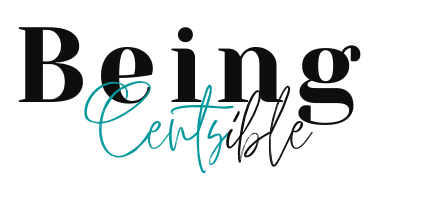“Whatever may be said in praise of poverty, the fact remains that it is not possible to live a really complete or successful life unless one is rich. “
– Wallace Wattles, The Science of Getting Rich
Hi there, and welcome to Being Centsible!
I am so happy you’re here and ready to learn how to create financial freedom.
This entire blog is about how to achieve financial freedom, and I’m excited to share all the money lessons I’ve learned on my journey toward financial independence.
I can now say with total confidence that I love money.
Money is my best friend, and I could talk about it all day long.
And I want nothing more than for you to have a great relationship with money too.
To find true financial freedom, here’s what you must embrace:
You Have a Responsibility to Achieve Financial Freedom
You have no time to feel funny about money.
Life is about becoming the best version of you, which requires developing your mind, body, and soul.
You can’t grow into the best version of yourself without access to things, services, and experiences.
Books and quality education are essential to growing your mind.
Travel opportunities to experience the beauty and diversity of life are just as important.
Healthy food and physical activity are necessary for a strong body.
Art, creativity, and spirituality are vital to the soul.
Our greatest happiness comes from our ability to help and give to others.
And as Wallace Wattles said in his famous money book, we also need “freedom from excessive toil.”
Life can’t be all work and no play. Rest is just as important to our health as a nutritious meal.
But all of these things require money.
So, becoming wealthy and achieving financial freedom is not greedy; it’s a fundamental requirement of life.
But unfortunately, we are never taught about money or creating financial freedom.
We are discouraged from talking about money because society tells us it’s evil and greedy.
No wonder money can feel complicated and overwhelming.
But if you’re willing to ignore all the lies society throws at you and instead embrace your duty to create financial freedom, there is a step-by-step path you can follow.
The plan to achieve financial freedom has eight steps, to be exact.
STEP 1: Create a Positive Money Mindset
Creating financial freedom requires you to let go of limiting money beliefs.
Did you cringe when I said I love money?
Did you think it was tacky?
Or perhaps a greedy thing to say?
If you did, you have to let that go. Because it means you think money is wrong and the love of money is a bad thing.
You will not create more money in your life if you think money is wrong.
Money isn’t wrong or bad or evil.
It’s simply a tool to trade in exchange for the things and services you need to become the best version of yourself.
So, when I said I love money, I was saying that I love becoming the best version of myself; because I do!
To achieve financial freedom, you need to stop believing:
“Money is the root of all evil.”
“I don’t have enough money.”
“Earning money takes hard work.”
“I can’t afford that.”
Letting go of negative beliefs takes time, but it’s the best use of your time.
To create a positive money mindset, check out The Secret to Overcoming Your Limiting Beliefs. The mindset exercise I share will help you uncover the negative beliefs holding you back.
You can also grab a copy of the following money books that will help you start thinking your way to abundance and wealth:
Once you’ve discovered your limiting beliefs (and started to change them), you’re ready for Step 2.

STEP 2 – Jumpstart a Healthy Lifestyle
Here’s a heads up – you’re not going to feel like budgeting or tracking your expenses.
You’ll prefer to turn on Netflix and snack on nachos.
And if you’re not in the best shape, the less motivated you’ll be to do anything other than binge-watch TV.
Not feeling your best is the fastest way to procrastinate and avoid your finances.
And avoiding your finances is the surest way to stay broke!
To improve your money situation, you need physical energy and focused thinking.
That’s why you need HEALTH if you want WEALTH.
Please don’t skip this step. Improving your finances is a marathon, not a sprint. Don’t race to other actions just because you think creating a budget and saving money is the answer.
You need a healthy mind and body to fix your money problems and so much more.
Here are 6 habits to implement to jumpstart a healthy lifestyle:
- Eat Clean – Eliminate artificial sweeteners, processed, and GMO foods from your diet. Limit sugar, alcohol, coffee, dairy, soy, and gluten. A clean diet is vital for high energy and clear thinking. My favorite place to find the best clean and organic brands is Thrive Market.
- Avoid Foods that Cause Allergies – Certain foods like dairy, gluten, and soy are known to cause allergies, so eliminate them from your diet.
- Eat every 4 to 6 hours – By eating frequent meals, you avoid going hungry and getting cravings.
- Meal Plan – Meal planning is a great way to eat healthy while saving money on groceries. To make meal planning super easy while saving money, check out $5 Meal Plan.
- Manage Stress – Stress can lead to health problems, so find ways to reduce stress, such as meditation. I learned meditation from Emily Fletcher, a leading teacher who shares a simple and effective meditation method that can fit into any busy life.
- Get moving – Schedule at least 15 minutes per day for a brisk walk. Then find ways to increase your physical activity.
Once you’ve implemented these habits into your daily routine, continue to Step 3.
To read more on how to implement a healthy lifestyle, check out:
STEP 3 – Create a Budget
Okay, so I realize the idea of creating a budget doesn’t exactly make you jump for joy.
But trust me, a budget is a beautiful thing.
A budget is an essential tool for managing your money because you become aware of your spending habits. When you budget, you notice the areas where you’re overspending.
Budgeting helps you achieve your money goals.
It’s all about awareness, and the key to a successful budget is to find a system that works for you.
I use a budgeting app called YNAB, and it’s been a game-changer. YNAB is based on the zero-based budgeting method, and the idea is that you give every dollar a purpose.
There are many different budgeting methods, and one size does not fit all. The key is to find a way that works for you. In future posts, I’ll share other budgeting methods.
If you’re just starting with budgeting, you can check out:
Once you have a budget in place, continue to Step 4.
STEP 4 – Build an Emergency Fund
Like budgeting, saving for emergencies is essential for your financial independence.
An emergency fund is a cash reserve you hold in a bank account for situations like unexpected repairs, medical bills, or losing your job.
Emergencies WILL happen, and the last thing you want is to use credit cards or tap into your retirement fund.
That’s why you need to prepare and build a financial cushion.
The easiest way I have found to save is to automate savings, and with the Digit savings app putting money aside for emergencies is super easy.
I love Digit because it analyzes your spending habits, calculates an amount you can save, and periodically moves the funds into an account to help you reach your goals.
Financial guru Dave Ramsey recommends saving $1,000 in emergency money.
$1,000 is an excellent start to help with minor emergencies, but in today’s world, $1,000 won’t keep you afloat for very long.
So, I recommend saving 3 to 6 months of necessary expenses.
Make sure to add your emergency fund as an item in your budget and once you have 3 to 6 months of savings, move to Step 5.
STEP 5 – Pay Down Debt
First things first – STOP feeling bad about your debt.
As you learned from the blog post I shared in STEP 1, debt is neutral.
Neither good nor bad until you have a thought that makes it good or bad.
Nothing positive comes from feeling bad about your debt, so look at the bright side of debt.
“Are you crazy?”, you say. “There’s no bright side to debt!”
Ah, yes, there is. Everything has a bright side, including debt.
Make a list of all your debts, including student loans and car loans, and write down the experiences your purchases made possible.
If you haven’t already done so, download my free Financial Organization Workbook to start tracking all your debts.
I’m not saying that staying in debt is a good thing. I’m suggesting that you feel gratitude for the items and experiences you purchased.
If it’s student loan debt, make a list of all the employment and business opportunities your higher education has made possible.
My student loans allowed me to earn a law degree and run my law practice. Thank you, student loans. I am super grateful to you.
If it is credit card debt, think about the vacation you paid for and all the family memories you can treasure forever. Look back through your pictures and experience the fun all over again.
Seriously, I’m going to repeat this! The foundation of creating financial freedom is a positive mindset, so choose gratitude over resentment when it comes to debt.
Now that you’re in a positive mindset, let’s start paying down the debt. You can use the Digit app to automate saving money and pay down your debts.
You can also use the Debt Snowball Method or the Debt Avalanche Method to start tackling your debts.
The Debt Snowball method is all about paying down the smallest debt first and working your way up. The success comes from seeing the small wins add up to big results.
The Debt Avalanche Method focuses on paying down the most expensive debt first. So, the goal is to pay off the debt with the highest interest rate.
For both methods, you focus on one debt and make the minimum payments on the rest.
Like a budget, one payoff method does not fit all. So, read up on both methods and pick the one that resonates the most. Choose one debt to pay off and add the monthly paydown amount as an item in your budget, just like your emergency fund.
Depending on the amount of debt, Step 5 may take you several months or longer. That’s okay. Remember, financial freedom is a marathon, not a sprint.
Once you’ve paid off your primary consumer debts, like credit cards, it’s time to move to Step 6 and start saving for short and long-term goals.
STEP 6 – Save for Short and Long-Term Goals
Whether you’re saving for a new computer or your first home, saving is a must if you want financial freedom.
Here are the steps I recommend to successfully save for your short and long-term goals:
- Have a separate savings account for your emergency fund.
- You can also open a CD or a high-yield bank account to hold your savings.
- Decide what you want and make a list of short and long-term goals.
- Figure out how much money you need to achieve each goal. For example, how much does the new computer cost?
- Set a deadline by when you want the money saved.
- Calculate your monthly contribution (The amount divided by the months to save).
- Add the monthly contribution to your budget.
- Automate your savings with the Digit app until you reach your goal.
- After achieving a goal, add a new one, and repeat the process.
Once you have your goals and savings in place, you are ready for the final step – Build wealth.
STEP 7 – Build Wealth
Congratulations! By this point, if you’ve followed the previous 6 steps, you’ve improved your mindset, started a healthier lifestyle, paid off debt, and saved money.
Please pat yourself on the back because you’re on the fast track to financial freedom.
Here is the best part – you’ve already started building wealth, and Step 7 is just about taking that wealth to the next level.
There are just a few principles to keep in mind when building wealth:
Avoid Debt
In Step 5, you worked hard to pay off your high-interest debt, so make sure you don’t return to old habits. Stay clear of consumer debt by continuing to budget and grow your savings.
Save for Retirement
Retirement plans like a 401(K) and Roth IRAs are great wealth-building tools. So, take advantage, and invest 15% or more of your income for retirement. Read this article to learn the difference between a 401(K) and IRA. Speaking with a financial advisor about your retirement plan is also recommended.
Accumulate Assets
According to Robert Kiyosaki, author of Rich Dad Poor Dad, an asset puts money in your pockets. Anything else is a liability.
For example, your house is a liability because you have expenses (property taxes and insurance) and no income even after paying off the mortgage.
On the other hand, rental property is an asset because the rent puts money in your pocket. So, consider investing in assets like a rental property. Also, start investing in the stock market. Investing money in assets like stocks and high-yield bonds is something you can learn and a great way to build wealth.
Create Passive Income
For me, financial freedom means that you no longer have to trade your time for money.
Time is your most valuable asset, so why exchange it for income when there are other easier ways to make money.
I’m not saying making money doesn’t require time. I’m saying that money is limited when tied to time because time is limited.
For example, if you earn $20.00 per hour and work eight hours per day, you are limited to making $160 per day. The only way to earn more is to work more hours, but your time is limited.
Instead, you want to find ways to work ONCE to create something of value that earns income repeatedly. For example, how about spending 8 hours to write an ebook that you can sell on Amazon for $20.00. This type of money is connected to value, not time. The amount of ebooks you can sell is unlimited, and so is your income.
You can check out How to Earn Money Online and Make Extra Cash for passive income ideas.
STEP 8 – Protect Your Wealth
Insurance and estate planning are the best way to protect your hard-earned wealth. Consider working with a financial advisor to understand more about asset protection.
Insurance
Your first line of protection is insurance, and there are several types of insurance you should consider.
Auto, home, and health insurance you likely own, so I won’t go into those topics in this post. However, you can compare prices with Policygenius and see if you can save money on your annual premiums.
Life Insurance
This type of insurance helps you care for your loved ones if something happens to you. The insurance company pays out a sum of money on the insured person’s death. Life insurance essentially replaces your income, so consider purchasing life insurance if you have a family depending on you.
Disability Insurance
Disability insurance helps cover your expenses if you can’t work because of injury or sickness. People often overlook disability insurance until it’s too late, so consider looking into getting a policy.
Personal Liability
In some situations, your primary auto, and home insurance might not be enough to cover a loss. An umbrella personal liability insurance is extra coverage beyond your insurance limits. It provides an additional layer of protection if there is a high loss risk.
I highly recommend looking into these other types of insurance so you can be protected against any unexpected event. Policygenius makes it super easy to help you compare prices and find the right policy for you.
Estate Planning
Having an estate plan is one of the most important things you can put into place to protect your loved ones. Unfortunately, too many people procrastinate until it’s too late.
An estate plan is a set of legal documents indicating how you want to distribute your wealth and assets to your family. It can also help you plan financial and health care decisions if you are incapacitated.
The most common estate planning documents are:
- Last Will and Testament
- Revocable Trust
- Durable Power of Attorney for Finances
- Advance Health Care Directive
The documents to include in your estate plan will depend on your specific situation. You can learn more about each document by clicking here.
If you are thinking of creating an estate plan, you can check out my eBook called Planning Your Estate and learn how the process works. When creating your plan, I also highly recommend working with a good estate planning attorney and financial advisor.
Another helpful resource is: 3 Legal Reasons to Create an Estate Plan
Take Action
Don’t overthink the 8 Steps to Financial Freedom. Just take action and start at STEP 1.
Remember, the foundation for financial freedom is having a positive mindset and a healthy mind and body, so you need to get healthy mentally and physically regardless of where you are with money. Then jump into budgeting, saving, building, and protecting wealth.








These are great tips to help people balance their finances and save for the future.
Budgeting and building my emergency fund are currently on the top of my list right now. These are very helpful tips to consider.
We feel a little more free since paying off one of our credit cards. That felt good!
Thank you for sharing this! I’m on my way to paying down debt. Little by little!
I so agree with STOP feeling bad about debt. Once I changed my mindset about debt my life got so much easier. I think so many people have their identity tied into their debt and it hurts them so much.
Being financially independent is one thing everyone wants to achieve. Great tips you got there. I’m always having a budget as well for everything so I can balance my outgoing expenses.